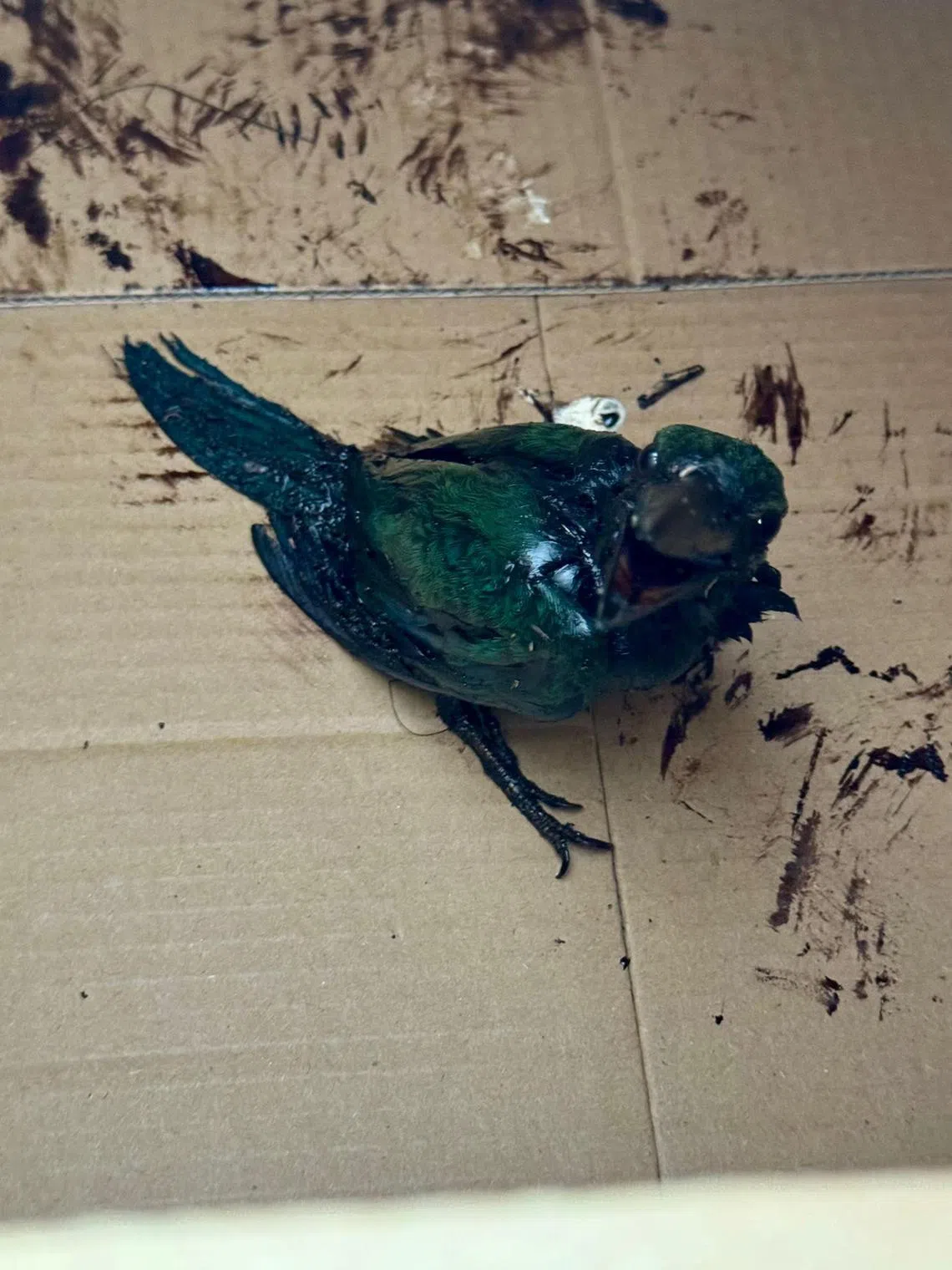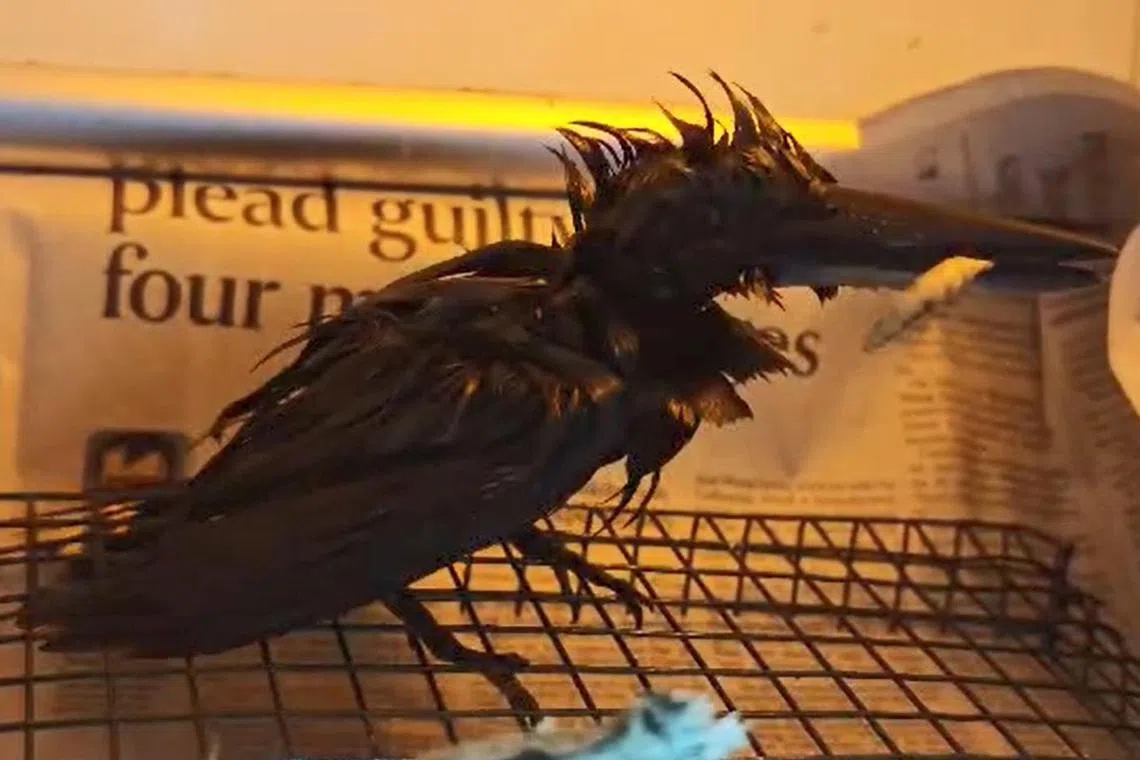Oil spill incident: Four kingfishers rescued so far, two have died
Sign up now: Get ST's newsletters delivered to your inbox

This kingfisher died on June 16, about 36 hours after it was rescued.
PHOTO: KALAI VANAN BALAKRISHNAN
Follow topic:
SINGAPORE – Four oil-coated collared kingfishers were rescued in the aftermath of the oil spill on June 14,
The National Parks Board (NParks) and wildlife rescue group Acres each rescued two kingfishers, The Straits Times has learnt. Of the two birds that died, one was helped by NParks and the other by Acres.
The two rescued by NParks were sent to the Centre for Wildlife Rehabilitation for veterinary treatment and care, said the board’s group director Anna Wong.
She said that despite prompt veterinary care, one of the birds died.
“The survival rate for these birds is low even with prompt veterinary intervention due to stress and accidental ingestion of oil which is toxic to them,” she added.
One kingfisher under the care of Acres died on June 16, about 36 hours after it was rescued.
The team could not pinpoint the exact reasons for its death, but the bird had signs of dehydration, Acres co-chief executive Kalai Vanan Balakrishnan told ST.
As for the other bird that is recovering, Mr Kalai said it has only about a 30 per cent chance of survival.
Acres – or the Animal Concerns Research and Education Society – is expecting to receive more reports on wildlife casualties due to the oil slick, he said.
Already, the group has received reports about other animals, such as otters and monitor lizards, being covered in oil, but the rescue team have not been able to locate them.
Members of the public have also seen other oil-coated animals.
Mr Bernard Seah, a wildlife photographer and conservationist, spotted two – a lesser sand plover and a blacktip reef shark – at St John’s Island on June 16.

A lesser sand plover partially covered in oil photographed at St John’s Island.
PHOTO: BERNARD SEAH
The oil spill was due to the Netherlands-flagged dredging boat Vox Maxima hitting the stationary Singapore-flagged bunker vessel Marine Honour
The damaged cargo tank on Marine Honour, which was near Pasir Panjang Terminal at the time, leaked oil into the sea, resulting in oil slicks at Sentosa, the southern islands, and in Changi.
Acres rescued one collared kingfisher from Lazarus Island, an offshore island about a 40-minute boat ride from Marina South, and another from the Keppel area on the mainland.
The first kingfisher was found on June 14, the day of the oil spill, while the second one was rescued on June 17, said Mr Kalai.

A kingfisher covered in oil when it was rescued.
PHOTO: KALAI VANAN BALAKRISHNAN
The collared kingfisher is the most common species of kingfisher in Singapore. It can be found throughout the country, including in urban areas away from water.
It is distinguished by a white band around its neck and white underparts, and has a turquoise-blue back and wings.
It feeds on fish, which it catches by diving into the water. That may have resulted in the kingfishers being coated in oil.
The impact of oil slicks on birds is larger than for other animals as it affects their ability to move, said Mr Kalai.
“The moment their feathers get impacted by oil, they are totally stranded. When they can’t fly, they’re really in big trouble.”
The process of cleaning the oil off an animal can be stressful for the creature, he added.

Cotton buds used to clean a kingfisher’s beak are stained with oil.
PHOTO: KALAI VANAN BALAKRISHNAN
To reduce the stress on the remaining kingfisher, the team at Acres is cleaning the oil off in phases, and using sedatives to help it calm down. The team has managed to clean the bird only three times since it was rescued, he said.
“Even then, there has been an improvement of only about 20 per cent,” said Mr Kalai.
Currently, the bird is well enough to eat worms the team feeds it, but Mr Kalai said it is still a long way from being able to fly again.

Currently, the bird is able to eat worms, but Acres co-chief executive Kalai Vanan Balakrishnan said it is still a long way from being able to fly again.
PHOTO: KALAI VANAN BALAKRISHNAN
He said that in 2023, Acres rescued a kingfisher from a glue trap and it took a year after the glue was removed before the bird could finally be released back into the wild.
NParks’ Dr Wong said that after the birds were taken to the Centre for Wildlife Rehabilitation, a clinical examination was performed to check for injuries, and fluids and pain relief were provided.
“The mouth, eyes and nasal areas were also cleaned to reduce any further inhalation or ingestion of the oil. Once stabilised, they were hand-fed and also slowly washed with detergent and warm water to minimise further stress to the animals,” she said.
Mr N. Sivasothi, a senior lecturer at the National University of Singapore, said animals that are caught in oil spills can suffocate or be poisoned.
For birds, oil on their feathers prevents them from flying and staying warm.
Animals like otters and turtles, or even fish that swim close to the surface of the water, can also be affected by oil slicks.
Animals that live in the intertidal zone – the area that is exposed to air at low tide and submerged at high tide – are also likely to get coated in oil.
“When the tide recedes, the layer of oil will coat the intertidal shore,” Mr Sivasothi said.

A blacktip reef shark sighted at St John’s Island, with patches of oil on the water surface.
PHOTO: BERNARD SEAH
He is hopeful that otters can recover from the oil spill as they can rub the oil off themselves and move to areas with fewer oil patches.
Mr Kalai said that people who spot oil-coated animals should not attempt to clean them on their own.
“You need a good environment, a good team of vets, and a plan... Removing the oil is just 50 per cent of the work,” said Mr Kalai, adding that the other 50 per cent is time and recovery.
Biodiversity surveys conducted by scientists as well as volunteers from Friends of Marine Park at St John’s Island and Lazarus Island on June 16 had indicated no significant impact on the marine biodiversity there
NParks will continue to monitor the impact of the oil spill on Singapore’s marine habitats, including corals and other wildlife, she added.
The agency will also assess if habitat restoration efforts are required.
Members of the public who encounter animals affected by oil slicks can contact NParks’ Animal Response Centre on its 24-hour helpline on 1800-476-1600, or Acres’ Wildlife Rescue Hotline on 9783-7782 from 7am-1am.

